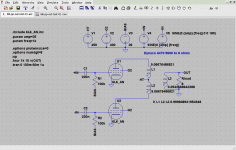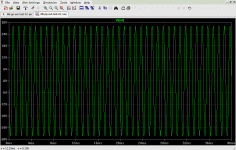Does anyone know where to get zmodels.lib, containing all Zetex BJT models? It can't be downloaded from the Diodes website and it appears current versions of the file may have had obsolete BJTs removed.
Also Phillips/NXP had a BJT model library, and IIRC they also removed current BJTs. Does anyone have the original libraries with all the models present?
Also aren't there similar libraries for NEC, Tochiba etc?
Also Phillips/NXP had a BJT model library, and IIRC they also removed current BJTs. Does anyone have the original libraries with all the models present?
Also aren't there similar libraries for NEC, Tochiba etc?
Well, Datasheetarchive.com actually has various versions of these files stored that you can look up. This gives some good clues as to the libraries available:
vendor - Datasheet Archive
I still haven't found the library that's the source of all the terrible 2SC/2SA models though.
vendor - Datasheet Archive
I still haven't found the library that's the source of all the terrible 2SC/2SA models though.
Some More
Dale
These may be all RF parts. I haven't found any Toshiba yet.. . . Also aren't there similar libraries for NEC, Tochiba etc?
Dale
Attachments
Thanks.
I was actually able to find all those on datasheetarchive.com, even some gems. Summary of what I found:
vendor - Datasheet Archive list of existing libraries
motor_rf - Datasheet Archive Motorola RF transistors
on_bjt - Datasheet Archive OnSemi library - pretty bad
infineon_s_afbjt - Datasheet Archive Infineon BJTs - not bad but not very good either
phil_bjt - Datasheet Archive Phillips BJT models - mostly okay
phil_bjt - Datasheet Archive More Phillips models
diode3 - Datasheet Archive Mainly obsolete diodes
zetexrf - Datasheet Archive (copy of zetex.lib with a few differences)
zetex - Datasheet Archive 1992 Zetex library - has unbelievable parameters on many models.
zmodels - Datasheet Archive 1995 Zetex library
zmodels - Datasheet Archive 1997 Zetex library
zmodels - Datasheet Archive 1997 Alternate Zetex library (?)
zmodels - Datasheet Archive 2003 Quasi-saturation models!!! Still has some unbelievable parameters though.
zetex - Datasheet Archive 2003? good ZVNxxxx MOSFETs
japan - Datasheet Archive Lots of trash - maybe the Jfet models are okay, maybe a few good BJT models
mcebjt - Datasheet Archive MicroCode Engineering 1997 - missing Itf, Vtf, Xtf
bjtn - Datasheet Archive 1997 Intusoft NPNs - Many Japanese transistors including Sanyo, but missing Itf, Vtf, Xtf
bjtp - Datasheet Archive 1997 Intusoft PNPs - missing Itf, Vtf, Xtf. Maybe good to base new models on.
bipolar - Datasheet Archive 1995 MicroSim - Rb=10 and don't ask questions
bipolar - Datasheet Archive 1998 OrCad - Seems to be a copy of the MicroSim library
bipolar - Datasheet Archive 2002 Cadence - Another clone of the MicroSim library
jfet - Datasheet Archive 1997 Intusoft Jfets, including Japanese types
jjfet - Datasheet Archive 2001 Cadence Japanese Jfets
Unfortunately most of these models are useless because those transistors are out of production. Assuming they weren't useless from the beginning because they're terrible models. It's still quite a gamble.
I was actually able to find all those on datasheetarchive.com, even some gems. Summary of what I found:
vendor - Datasheet Archive list of existing libraries
motor_rf - Datasheet Archive Motorola RF transistors
on_bjt - Datasheet Archive OnSemi library - pretty bad
infineon_s_afbjt - Datasheet Archive Infineon BJTs - not bad but not very good either
phil_bjt - Datasheet Archive Phillips BJT models - mostly okay
phil_bjt - Datasheet Archive More Phillips models
diode3 - Datasheet Archive Mainly obsolete diodes
zetexrf - Datasheet Archive (copy of zetex.lib with a few differences)
zetex - Datasheet Archive 1992 Zetex library - has unbelievable parameters on many models.
zmodels - Datasheet Archive 1995 Zetex library
zmodels - Datasheet Archive 1997 Zetex library
zmodels - Datasheet Archive 1997 Alternate Zetex library (?)
zmodels - Datasheet Archive 2003 Quasi-saturation models!!! Still has some unbelievable parameters though.
zetex - Datasheet Archive 2003? good ZVNxxxx MOSFETs
japan - Datasheet Archive Lots of trash - maybe the Jfet models are okay, maybe a few good BJT models
mcebjt - Datasheet Archive MicroCode Engineering 1997 - missing Itf, Vtf, Xtf
bjtn - Datasheet Archive 1997 Intusoft NPNs - Many Japanese transistors including Sanyo, but missing Itf, Vtf, Xtf
bjtp - Datasheet Archive 1997 Intusoft PNPs - missing Itf, Vtf, Xtf. Maybe good to base new models on.
bipolar - Datasheet Archive 1995 MicroSim - Rb=10 and don't ask questions
bipolar - Datasheet Archive 1998 OrCad - Seems to be a copy of the MicroSim library
bipolar - Datasheet Archive 2002 Cadence - Another clone of the MicroSim library
jfet - Datasheet Archive 1997 Intusoft Jfets, including Japanese types
jjfet - Datasheet Archive 2001 Cadence Japanese Jfets
Unfortunately most of these models are useless because those transistors are out of production. Assuming they weren't useless from the beginning because they're terrible models. It's still quite a gamble.
Maybe it's this one from Orcad.I still haven't found the library that's the source of all the terrible 2SC/2SA models though.

Attachments
Yep, that one is probably it. I have a suspicion that someone at OrCad or whatever had all the models nicely extracted, compiled into a spreadsheet, then pressed the wrong button and ruined all that hard work without having any idea.
Is there a library for components such as speakers and microphones, or can they be modeled for simulation purposes?
I've never seen a library for speakers or microphones. I think people just make their own models when they need one. A lot of people make their own models without making them public. Just a speaker's impedance can be hard to model realistically, let alone what happens to it when the diaphragm is in motion.
There is a very real limitation of simulation, which occurs when it would be easier to construct a prototype with alligator clips than to attempt to simulate it. You may very well spend a day or two just figuring out how to construct the model, although it gets significantly faster the more you do it.
There is a very real limitation of simulation, which occurs when it would be easier to construct a prototype with alligator clips than to attempt to simulate it. You may very well spend a day or two just figuring out how to construct the model, although it gets significantly faster the more you do it.
I'm attempting my first sim of a tube output stage (for learning purposes, not a real design) and although it's working, the output seems wrong.
It's a simple 6L6 PP stage where I bias it per the GE data sheet. The model is Ayumi. I can only get up to about 27W ouput before clipping (at 7%THD), which is wrong both from the GE datasheet and practical experience. Any more input and it clips.
Any help pointing out my error(s) would be appreciated.
It's a simple 6L6 PP stage where I bias it per the GE data sheet. The model is Ayumi. I can only get up to about 27W ouput before clipping (at 7%THD), which is wrong both from the GE datasheet and practical experience. Any more input and it clips.
Any help pointing out my error(s) would be appreciated.
Attachments
Any help pointing out my error(s) would be appreciated.
IMHO triode connection is better. Connect G2 to anode with 100R and decrease B+ to 400V.
OPT parameters?
Last edited:
@euro21, thanks but I believe you didn't understand the question. I didn't ask for an opinion on design. I am asking for help making the sim work correctly. The object is to play with the sim and gain knowledge and experience with spice.
OPT includes resistances of 100ohm primary P-P and 0.3ohm secondary. Not trying to sim any specific OPT, just picked some reasonable numbers to make the sim work.
OPT includes resistances of 100ohm primary P-P and 0.3ohm secondary. Not trying to sim any specific OPT, just picked some reasonable numbers to make the sim work.
I think your calculations for your OPT may be a little off.I'm attempting my first sim of a tube output stage (for learning purposes, not a real design) and although it's working, the output seems wrong.
It's a simple 6L6 PP stage where I bias it per the GE data sheet. The model is Ayumi. I can only get up to about 27W ouput before clipping (at 7%THD), which is wrong both from the GE datasheet and practical experience. Any more input and it clips.
Any help pointing out my error(s) would be appreciated.

I copied and pasted some values for a Dynaco A470 OPT that swiped from a spreadsheet from a fellow member here, Robert McLean. I got over over 50 watts at 1.5% THD. Heres's a couple of pretty screenies to look at. 😀
Try this (zipped file in the attachment below) in LTspice.
Attachments
Here is the link to the spreadsheet.
http://www.diyaudio.com/forums/tubes-valves/181578-spice-transformer-model-spreadsheet.html
http://www.diyaudio.com/forums/tubes-valves/181578-spice-transformer-model-spreadsheet.html
Could you explain the coupling factors for the transformer?
L1 = 9.066
L2=9.066
L3=0.05426
K L1 L2 L3 = 0.9996
BTW,
I like the separation of all the supply voltages reffed to a common rail.
Makes the sch much simpler and thus easy to read.
L1 = 9.066
L2=9.066
L3=0.05426
K L1 L2 L3 = 0.9996
BTW,
I like the separation of all the supply voltages reffed to a common rail.
Makes the sch much simpler and thus easy to read.
Last edited:
I think your calculations for your OPT may be a little off.
Thanks Cogs. Indeed my OPT arithmetic was out to lunch for some reason. Works fine now. By the way, I'm not sure where he got the data for the spreadsheet, but every new A470 I've seen is advertised as 4.3k primary, not 5.6k. The model is 5.6k and works fine. Perhaps the original Dyna was 5.6k?
Yes, 4.3k, that's what I've always read. 5.6k, where did that come from? Can be corrected in the spreadsheet. Thanks for pointing that out. But hey, it works for your sim! 😀
http://www.clarisonus.com/Archives/Trans/Dynaco_transformer.pdf
http://www.clarisonus.com/Archives/Trans/Dynaco_transformer.pdf
Not sure where that 5.6k came from but by luck that's exactly what I was using in the sim per the GE data sheet op point I was trying to sim. Sometimes a blind squirrel gets a nut🙂
2H / 0.0057H = 350.87
350.87 * 4 = 1403.48
1403.48 * 8 = 11227.84
using McNeal's spreadsheet, with this numbers you got a OPT with f3 110Hz, fh 20Khz, PP load around 11200R
350.87 * 4 = 1403.48
1403.48 * 8 = 11227.84
using McNeal's spreadsheet, with this numbers you got a OPT with f3 110Hz, fh 20Khz, PP load around 11200R
Hi all (& not least Mooly),
I just briefly read through parts of the thread and it looks very interesting indeed - I hope I'll have time to read through more of it with a purpose to learn LTSpice in more depth. Thanks for making this information available Mooly (& others) ;-)
My reason for posting now, however, is that I've been looking for a way to measure distortion differentially. Might one of you know if this has been discussed in the thread - and if so then where?
Thanks for any help - cheers,
Jesper
I just briefly read through parts of the thread and it looks very interesting indeed - I hope I'll have time to read through more of it with a purpose to learn LTSpice in more depth. Thanks for making this information available Mooly (& others) ;-)
My reason for posting now, however, is that I've been looking for a way to measure distortion differentially. Might one of you know if this has been discussed in the thread - and if so then where?
Thanks for any help - cheers,
Jesper
- Home
- Design & Build
- Software Tools
- Installing and using LTspice IV (now including LTXVII), From beginner to advanced



